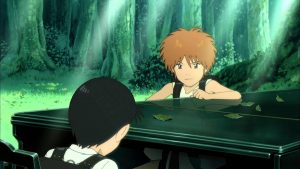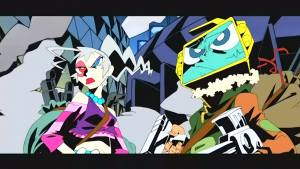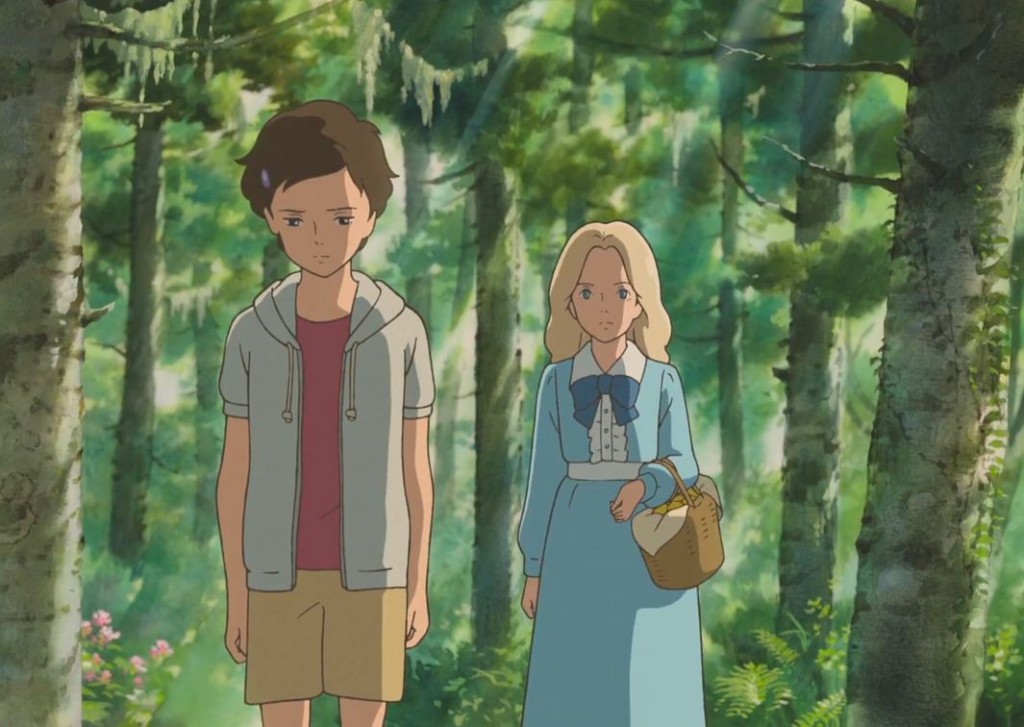October 10th, 2019 in Anime, Movies by The Droid

I always have a problem with anime movies, in that I am aware of the merest tip of the iceberg that comes to a regular cinema on its own (although I am having troubles with “The Red Turtle” and that’s a Studio Ghibli offering). A tremendous amount of them just go drifting past, so it is a bit or a workout to be able to find them without having to go to some special showing in a theater no one can find at exorbitant costs to view it and you have but one weekend to grab any of the four total showings. And the next nearest theater for it is 600 miles away. That is why when I run into an anime movie, I grab it and take my chances.
Such is the case with “Kokoro ga Sakebitagatterunda” (“The Anthem of the Heart”, subtitled “Beautiful Word Beautiful World”). At its heart, it is a love story, but how we get there is a tad unusual. (more…)
Tags: Drama, Romance, School
October 3rd, 2019 in Anime, Movies by The Droid

I am seeing a lot of music animes popping up, and it’s not just folks wanting to be the latest idol band or boy group, but real musical dedication. After having seen “Your Lie in April” and bumbled through two season of “Hibike! Euphonium”, I decided that I would try out “Piano no Mori”, (“Piano’s Forest”) although it is a strange confabulation of events. Also, it’s an anime movie and you know my stance on them. I will watch it and decide later if it was worth it, as they get such a limited to no release at all in the US (more…)
Tags: Music, Mystery, Slice of Life
November 1st, 2018 in Anime, General Reviews, Movies by The Droid

One of the functions of anime is to push boundaries. It can’t always be giant fighting robots, or a high school rom-com with witches or espers or someone who thinks they are God or a look at an alternative history with hip-hop samurais. Yes, there is a danger in this approach, as you can frighten off the more timid souls who are afraid to leave their comfort zone and you end up being cult.
The only reason I found this older offering (2004; a lifetime in anime) is that I ran across an article about “15 Must-Watch Forgotten Anime” movies (well, I own four of them, so it wasn’t that big of a deal to me). It’s just this one, which was rated at Number 2, takes anime and animation and science fiction and violence and sex and bounces it on its noggin for 50 head-twisting minutes (well, actually 43; you have about seven minutes of credits). The short-hand to this film would be if FLCL took the brown acid, THIS is what you would get: “Dead Leaves” (“Deddo Rībusu”). (more…)
Tags: Action, Adventure, Sci-Fi
May 17th, 2018 in Anime, General Reviews, Movies by The Droid

Whew! At least we picked up the pace for the final installment of “Arpeggio of Blue Steel” (maybe; I can no longer tell if a series has truly ended any more), with “Ars Nova: Cadenza”. It’s musical history time. A ‘cadenza’ often refers to a portion of a concerto in which the orchestra stops playing, leaving the soloist to play alone in free time (without a strict, regular pulse) and can be written or improvised, depending on what the composer specifies. The final movie is like that, as so much ‘new stuff’ comes in, that we are left in its wake.
The good news is that this is a full and true movie. We have progressed beyond the cut and paste of “D.C.” and formed a real film, with all the twists and turns you have come to expect from a submarine chase film. The time has come to end this war. (more…)
Tags: Action, Military, Sci-Fi
April 27th, 2018 in Anime, General Reviews, Movies by The Droid

More on Part Two of the movie “Suisei no Gargantia ~ Meguru Kōro, Haruka”. Now, as I previously pondered as to why they did not decide to make this a two-hour (or so) movie, I do not know. Personally, I felt it would have benefitted from such a move, but then you lose the cliff-hanger ending for Film A, which would drive you into seeing Film B to conclude the offering and make for a more complete understanding of what is going on, although, for the most part, you don’t know what is really going on.
It comes off as not much more than a travelogue, as we see the life of people on these giant city-fleets and how they deal with other people on their giant city-fleets, who come along with items for trade or barter, so you can purchase or swap for that which you don’t have or have never seen. Oh, the story. The real story. An item that was pulled up from the sea bed in the last film appears to be a massive memory storage unit and could potentially explain a great deal as to what is going on and could even have technology. A lost technology that could benefit us, but it could also destroy us! (more…)
Tags: Action, Adventure, Mecha, Romance
April 19th, 2018 in Anime, General Reviews, Movies by The Droid

One of my responsibilities as a reviewer is to note trends. One trend I have noticed is the ten-episode run of second seasons, and that bothers me to no end. Another is the Movie Conclusion. I first saw it with “Eden of the East”, but a few more are cropping up. It appears a decision has been made by the Parent Company that rather than hoisting another season of a show (even if it is 10 episodes), let’s use a movie or two to close it out or explain things better. Thus is the case with “Gargantia on the Verdurous Planet” (“Suisei no Garugantia”).
The initial series told the story of Ensign Ledo (right), a soldier in the Galactic Alliance, piloting a Machine Caliber. This is an AI-automated, humanoid-shaped battle suit, which he refers to as ‘Chamber’. After a failed attempt by the Alliance forces to destroy an enemy super-weapon, Ledo is knocked into a wormhole and loses consciousness. When he awakens, he learns from Chamber that he has been in hibernation for six months while his wounds were healing. Ledo also discovers that he and Chamber have been ‘found’ by a rag-tag band of human scavengers. (more…)
Tags: Action, Adventure, Romance
September 24th, 2015 in Anime, General Reviews, Movies, Rakuen Tsuihou by The Droid

The big problem that I have with anime movies is that I never get a real chance to see them in the theaters. With the exception of a lot (but not all) of Studio Ghibli, I would assume the bulk of these offerings never leave the Land of the Rising Sun. On those rare occasions that they do, it is a really limited release over the course of one weekend, in a movie theater that the bus lines don’t get to, at an outrageous ticket price (I had a chance to see “The Disappearance of Haruhi Suzumiya” like this, but the tickets were $20 each!) and with a grand total of five showings.
Thus, when I do encounter a movie, I give it a look-see, and I will potentially not get another shot at a look-see. This means it is pot luck at best. Like the Mystery Bag, whatever is whatever. I had a chance to see “Rakuen Tsuihou” (“Expelled from Paradise”), a film I heard nothing about at all, even though it has been out in the US for theoretically five months.
It is the future. Most anime is about the future. Angela Balzac is an agent at the space station DEVA, whose inhabitants have no physical bodies, their minds digitized and processed into a virtual reality environment. She has a day off and is ‘lounging’ at the ‘beach’ on a ‘wonderful day’. Seriously, if this is all VR, it’s not much different than the Matrix, right? Anyway, after some Village People clone tries to hit on her, the beach scene deteriorates, as they have been hacked by some initially unknown entity. (more…)
Tags: Action, Mecha, Sci-Fi
September 20th, 2015 in Anime, General Reviews, Movies, When Marnie was There by The Droid

I wonder what it takes for an anime film to get decent distribution in the US. I did see “Ponyo” and “The Wind Rises” in the theaters, but how many others have slid below the radar? I’m not even seeing ads taken out in the papers or things getting mentioned, so I have to wait for alternate distribution to find out about them at all and then get a chance to see the latest film releases. “When Marnie was There” (or “Marnie of the Memories”) came out last July and could, potentially, be the last film from Studio Ghibli, as they are ‘on hiatus’, but with the retirement of Miyazaki, their future is vague.
On to the film. I am uncertain when the film takes place, but it could be the late 60s or early 70s. Anna Sasaki (left) is a 12-year-old girl who lives in Sapporo with foster parents, Yoriko and her husband. Anna’s mom and dad died in a car accident and Grandma passed away a couple of years earlier, so there is no one for her. One day at school, she collapses from an asthma attack, so her parents send her to spend the summer with Setsu and Kiyomasa Oiwa, relatives of Yoriko, in Kushino, a rural seaside town, where the air is clear. (OK, we will ignore the fact that asthma isn’t tuberculosis). (more…)
Tags: Mystery, Psychology
September 10th, 2015 in Anime, General Reviews, Movies, The Tale of the Princess Kaguya by The Droid

Another Studio Ghibli release, “The Tale of the Princess Kaguya” (Kaguya-hime no Monogatari) is 95% of a marvelous film. A rather cheap-out ending mars an otherwise magnificent effort, both in story-telling and animation approach.
A bamboo cutter named Sanuki no Miyatsuko lives high in the mountains, plying his trade. One day, while doing his rounds, he discovers a glowing bamboo shoot. Inside is a tiny, tiny girl. Believing her to be a divine presence, Miyatsuko and his wife decide to raise her as their own, calling her “Princess“. The girl grows rapidly and conspicuously, marveling her parents and earning her the nickname “Takenoko” (Little Bamboo) from the other children in the village. Sutemaru, the oldest among Kaguya’s friends, develops a particularly close relationship with her. (more…)
Tags: Fantasy, Historical
December 15th, 2013 in Anime, General Reviews, Movies by The Droid

When is a movie not a movie? When is a series not a series? Why can’t you ever get a good answer to questions? Did you remember to turn off the iron?
I bring this up, as I am uncertain how to approach “Mardock Scramble”. If it is a movie, why isn’t it presented as such? At three hours, it is a bit long for a movie (especially an anime one), but it could have easily been broken up to be a first season of a show (a 12-episode run). I am going to call this a ‘special’, as it works best in that configuration. So, let’s get to the story, eh?
It could be the future, but it is certainly an alternate universe of Tokyo….I mean, Kamina City, Rune Balot is a 15-year old prostitute, who goes on a ‘date’ with the notorious Shell Septinous. Shell has a bit of a problem, in that he is a psychotic killer. He has sex with these underage ladies, and then murders them. Rune is no exception, as she is left to die in a burning car which explodes. However, she is rescued and transformed into a cyborg by the rather mysterious Dr. Easter. An Artificial Intelligence life form (more…)
Tags: Action, Psychological, Sci-Fi









